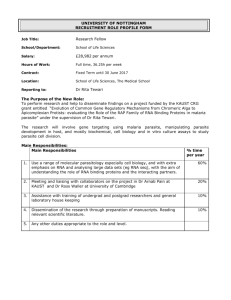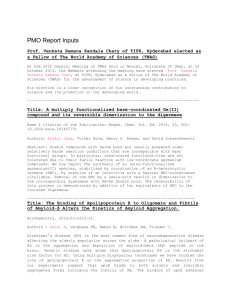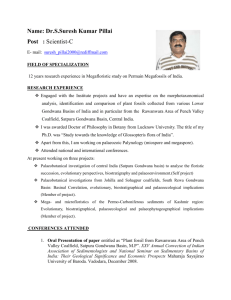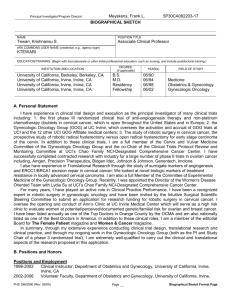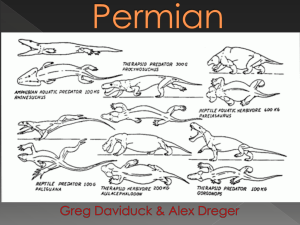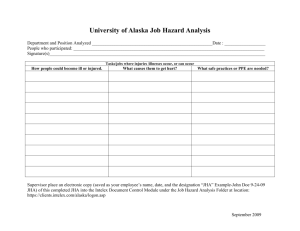DOC - Birbal Sahni Institute of Palaeobotany
advertisement
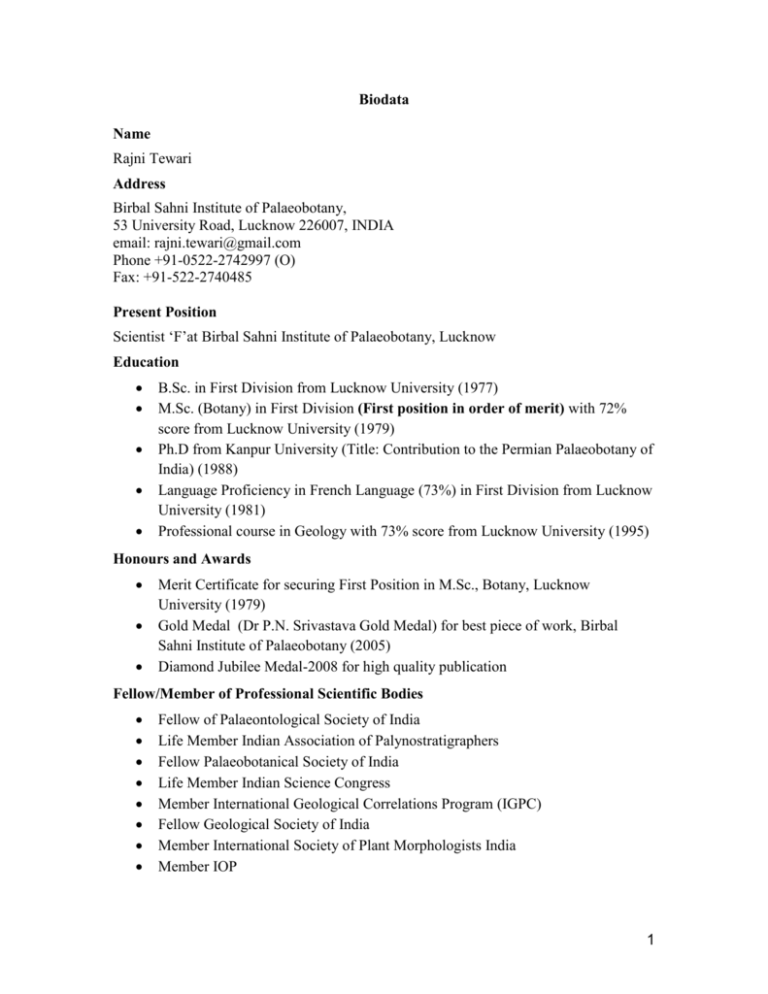
Biodata Name Rajni Tewari Address Birbal Sahni Institute of Palaeobotany, 53 University Road, Lucknow 226007, INDIA email: rajni.tewari@gmail.com Phone +91-0522-2742997 (O) Fax: +91-522-2740485 Present Position Scientist ‘F’at Birbal Sahni Institute of Palaeobotany, Lucknow Education B.Sc. in First Division from Lucknow University (1977) M.Sc. (Botany) in First Division (First position in order of merit) with 72% score from Lucknow University (1979) Ph.D from Kanpur University (Title: Contribution to the Permian Palaeobotany of India) (1988) Language Proficiency in French Language (73%) in First Division from Lucknow University (1981) Professional course in Geology with 73% score from Lucknow University (1995) Honours and Awards Merit Certificate for securing First Position in M.Sc., Botany, Lucknow University (1979) Gold Medal (Dr P.N. Srivastava Gold Medal) for best piece of work, Birbal Sahni Institute of Palaeobotany (2005) Diamond Jubilee Medal-2008 for high quality publication Fellow/Member of Professional Scientific Bodies Fellow of Palaeontological Society of India Life Member Indian Association of Palynostratigraphers Fellow Palaeobotanical Society of India Life Member Indian Science Congress Member International Geological Correlations Program (IGPC) Fellow Geological Society of India Member International Society of Plant Morphologists India Member IOP 1 Research Interests Multidisciplinary research approach to Gondwana Flora of India, Brazil and Antarctica Gondwana Megaspores Morphological studies on f Indian Gondwana megaspores along with their distribution pattern, basinal correlations, evolutionary and biostratigraphic significance has been carried out. Megaspores have been investigated from different basins namely, Damodar, Satpura, Wardha and Mahanadi. Permain Megafossils o Morphographical and cuticular studies in Permian megafossils including leaves, fructifications, equisetalean axes, ferns and seeds; evolutionary significance and extinction Dispersed Cuticles o Morphotaxonomic study of dispersed angiosperm leaf cuticles in relation to the affect of various degradation processes, including bacterial biodegradation, study of environment of deposition and palaeoenviroment. Cuticular studies in palaeo carbon dioxide (pCO2) estimation through stomatal index analysis Hydrocarbon Exploration in Neoproterzoic Basins of Indian Subcontinent International Collaborative projects Indo-Brazil S&T Joint Research Programme :Palaeobotanical studies on Indian and Brazilian sedimentary basins with special reference to marine dinoflagellate cysts, Gondwana flora and their applications (with Mary EC Bernardes de Oliveira, Mitsuru Arai, Maria Judite Garcia, Roberto Iannuzzi of Brazil) o Comparative studies on Early and Late Permian megafossils from Parana Basin, Brazil and Indian Gondwana sedimentary basins for better understanding of distribution and biostratigraphic corelation of Gondwana flora o Morphological studies on Pennsylvanian megaspores from Parana Basin, Brazil and their correlation with Indian Gondwana ○ Pennsylvanian lycopsids from an interglacial taphoflora of Itararé Group, Monte Mor (SP), in Northeastern border of Paraná Basin, Brazil 2 Comparative studies on Glossopteris and Dicroidium floras of Antarctica and India vis-à-vis palaeoclimatic implications (with Dr Sankar Chatterjee (Horn Prof.of Geology), Museum,Texas Tech University, Lubbock, US) o Comparative studies on megafossils from Early Permian (Weller Formation) and Triassic (Lashly Formation) from Allan Hills, Antarctica and Indian Gondwana sedimentary basins for better understanding of evolution, distribution and biostratigraphic correlation of Gondwana flora. Study is under progress o Charcoalified plant remains from the Lashly Formation of Allan hills, Antarctica: Evidences of Forest fire during Triassic period Training Programmes Leadership training for Senior Women Scientists in ASCI, Hyderabad during July 23-27, 2007 Hydrocarbon maturation studies in KDMIPE, ONGC, Dehradun during January 21-25, 2008 Modern Practices in Petroleum Exploration organised by Petrotech, Keshava Deva Malviya Institute of Petroleum Exploration (KDMIPE), Kaulagarh Road, Dehradun, September 22-27, 2008 Training on social, ethical and gender issues for women scientists in ASCI, Hyderabad during January 12-16, 2009 Training Programme on Ladies Excellence &Attitude Programme (L.E.A.P.) sponsored by DST, GOI held from 17-21 January 2011, at the International Centre Goa. Field Experience Extensive field experience of geological excursions undertaken for collection of plant megafossils and rock samples for recovery of megaspores and seeds throughout India viz. Damodar, Rajmahal, Son, Wardha, Krishna-Godavari basins, Nainital, North-East Himalayas including Arunachal Pradesh, Darjeeling and Sikkim,West Himalayas including Guling, Tabo (Spiti), Kinnaur District, Himachal Pradesh; Kashmir and Cerquilho, Parana Basin, Brazil. Visits Abroad In connection with different palaeobotanical/palaeontological conferences deputed to following places Paris, France Bonn, Germany Nanjing and Beijing,China Guarulhos, Sao Paulo, Buzios, Belém, Rio de Janiero, Natal, Brazil Leiden, Ámsterdam, The Netherlands 3 St. Petersburg and Moscow, Russia Perth, Australia In connection with International Collaborative projects Texas Tech University, Lubbock, Texas, US. Guarulhos and São Paulo Brazil Conferences About 40 National and International Conferences/Symposia/Workshops attended both in India and abroad Research Publications Total number of publications-75 Lectures delivered Delivered several lectures on Palaeontological aspects in different schools and degree colleges of Lucknow and to graduate, post graduate students and Faculty Members of Departments of Palaeontology and Geosciences of Universities of Guarulhos and São Paulo, respectively, Brazil. Any Other Organising Secretary Indo Brazilian Symposium on “Glimpses of Gondwana research” held at BSIP on Nov.24, 2010 Editor Geophytology (2007-2009) The Palaeobotanist (w. e. f. February 2011) Peer reviewer Of research papers for Indian and foreign journals As faculty member of the Contact Course in Advance Training in Palaeobotany, BSIP, Lucknow Imparted hands-on training on identification of Palaeozoic megafossils, preparation and study of fossil plant cuticles and megaspores to the participants of the course hailing from various states of India Convener Women Welfare Committee Member Smart Administrative Cell Museum committee Library committee 4 Organising Secretary / Member Organisation Committees Symposia / Seminars / Conferences within BSIP and NCAOR, Goa List of publications Total number of publications-75 Research publications in refereed International and National Journals : 68 Catalogues: 2 Popular Articles: 5 1. Maheshwari HK & Tewari R. 1986. Maheshwariella spinicornuta, a new gymnospermous seed from the Karharbari Formation. Palaeobotanist 36:69-72. 2. Maheshwari HK & Tewari R. 1987. Megaspore biostratigraphy of Gondwana. Palaeobotanist 36: 103 - 105. 3. Maheshwari HK & Tewari R.1989. Ancorisporites venkatachalae sp. nov. from Lower Permian of Bihar, India. Palaeobotanist 37: 152 - 154. 4. Tewari R. 1990. Epidermal morphology of Permian Gondwana gymnosperms. Palaeobotanist 38: 39-42. 5. Bajpai U & Tewari R. 1990. Plant fossils in upper beds of Raniganj Formation in Jharia Coalfield. Palaeobotanist 38: 43-48. 6. Maheshwari HK, Bajpai U & Tewari R. 1991. Climatic reflections in the Permian vegetation of Indian Peninsula. In: Ulbrich H and Rocha Campos AC (editors) Gondwana Seven Proceedings , Sao Paulo, Brazil, pp 549-556. 7. Tewari R. & Maheshwari HK. 1992. Megaspores from early Permian of India. Geophytology 21: 1-19. 8. Maheshwari HK & Tewari R. 1992. Epidermal morphology of some Indian species of the genus Glossopteris Brongniart. Palaeobotanist 39 : 338-380. 9. Srivastava AK & Tewari R. 1994. Possible evidences of bacterial degradation in Glossopteris flora of India. Palaeobotanist 42: 174-177. 10. Tewari R. 1996. Palaeobotanical investigations from Raniganj Formation of Jharia Coalfield. In: Guha PKS and Sengupta S (editors) Gondwana Nine Proceedings Vol. I, pp 135-43. 11. Tewari R. & Srivastava AK. 1996. Plant fossil assemblage from the Barakar Formation of Jharia Coalfield, Bihar. Geophytology 25: 35-39. 12. Srivastava AK & Tewari R. 1997. Plant fossils from the Barakar Formation of Auranga Coalfield. Geophytology 26: 83-88. 13. Tewari R. 1997. Glossopterid fructifications from Upper Permian of India - A morphographical correlation. Palaeobotanist. 45: 315-323. 14. Srivastava SC, Srivastava AK, Bhattacharyya AP, Tewari R. 1999. Degraded Permian palynomorphs from North-East Himalaya, India. Permophiles 33: 32-36. 5 15. Tewari R., Srivastava A.K. 2000. Plant fossil assemblages from Talchir Formation, Auranga Coalfield, Bihar. Palaeobotanist 49: 23-30. 16. Tewari R., Srivastava AK. 2000. Plant fossils from Bhareli Formation of Arunachal Pradesh North-East Himalaya, India. Palaeobotanist 49: 209-217. 17. Tewari R. 2000. Glossopteris ashwinii, a new name for Glossopteris schopfii Maheswhari and Tewari R. 1992. Palaeobotanist. 49: 529-530. 18. Tewari R., Madhav Kumar, Anand-Prakash, Shukla Manoj, Srivastava G.P. 2001. Dispersed angiospermous cuticles from a lignitic clay bed of Sindhudurg Formation, Maharashtra: an Interpretation on taxonomy, biodegradation and environment of deposition. Palaeobotanist 50: 369-380. 19. Tewari R. & Rajanikanth A. 2001. Occurrence of Glossopteris flora at Pisdura Nand-Dongargaon Sub Basin. Palaeobotanist 50: 411-414. 20. Tewari R., Agarwal A. 2001. Distinctive stomatal structures from dispersed leaf cuticles of Sindhudurg Formation, Maharashtra, India. Current Science 81(12): 1638 – 1641. 21. Tewari R. 2001. Extinction of the genus Glossopteris Brongniart – A view point. Revista Geociệncias 6: 35-41. 22. Srivastava AK & Tewari R. 2001. Development of Glossopteris flora in Indian Gondwana sequence. Revista Geociệncias 6: 42-49. 23. Srivastava AK & Tewari R. 2001. Lower Gondwana plant fossils from Barren Measures of Jharia Coalfield, Bihar, India in Dutta AB, et al (editors) Proceedings of National Seminar on Recent Advances in Geology of Coal and Lignite Basins of India, Calcutta, 1997, GSI special Publication. No. 54: 127-134. 24. Agarwal A, Tewari R. & Ambwani K. 2002. Dispersed angiospermous leaf cuticles from Sindhudurg Formation, Miocene, Ratnagiri District, Maharashtra, India. Phytomorphology 52(1): 29-38. 25. Srivastava AK & Tewari R. 2002. Two new types of megaspore from Permian Gondwana sequence of India. Permophiles 39: 28-31. 26. Srivastava AK & Tewari R. 2002. A new gulate megaspore from Satpura Gondwana Basin. Journal of Palaeontological Soceity of India 47: 93-96. 27. Jha Neerja & Tewari R. 2003. Megaspores from Raniganj Formation, Mailaram Area, Godavari Graben, Andhra Pradesh, India. Phytomorphology 53(2): 141156. 28. Joshi A, Tewari R., Mehrotra RC, Chakraborty PP and De A. 2003. Plant remains from Upper Siwalik sediments of West Kameng District, Arunachal Pradesh. J. geol. Soc. India 61: 319- 324. 6 29. Mehrotra RC, Tewari R. & Joshi A. 2003. Application of fossil cuticles in determining palaeoatmospheric CO2 concentration. Current Science 84(1): 93-94. 30. Tewari R. & Mehrotra RC. 2003. Cuticular fragments from the Makum Coalfield, Tinsukia District, Assam and their climatic significance. Phytomorphology 53: 269-284. 31. Srivastava AK & Tewari R. 2003.Morphological and cuticular studies of Permian Noeggerathiopsis leaves. Geophytology 32: 83-89. 32. Tewari R., Rajanikanth A & Jha N. 2004. Permian Gondwana megaspores of Wardha Basin, India. Palaeobotanist 53: 35-50. 33. Rajanikanth A & Tewari R. 2004. Environmental implications of Gondwana wood studies in India. Palaeobotanist 53: 69-82. 34. Srivastava AK & Tewari R. 2004.Megaspore assemblage from Pench Valley Coalfield, Madhya Pradesh, India. Geopyhtology.34: 57-64. 35. Tewari R., Mandaokar BD & Mehrotra, RC. 2005. Fossil cuticles from the Oligocene sediments of North-East India. J.appl. biol. Sci.31: 90-104. 36. Tewari R. & Jha N. 2006. Occurrence of Plant Mega- and Microfossils from Barakar and Raniganj formations of Manuguru Area, Godavari Graben, Andhra Pradesh. J. geol. Soc. India 67: 101-102. 37. Jha N & Tewari R. 2006. A comment on Gula and Gulate megaspores Curr. Sci. 91: 1010-1011. 38. Jha N, Tewari R. & Saleem M. 2006. Occurrence of megaspores in the Lower Gondwana sediments of the Gundala area, Godavari Graben, A.P., India. J. Palaeontol. Soc. India 51: 37-41. 39. Tewari R. & Jha N & Saleem M. 2007. Permian Megaspores from Kachinapalli Area, Gondwana Graben, India. Phytomorpholgy 57: 1-12. 40. Jha N, Tewari R. & Rajanikanth A. 2007. Palynology of Permian Gondwana Sequence of Umrer Coalfield, Maharashtra. J geol.Soc. India 69 (4): 851-857. 41. Jha N & Tewari R. 2007. Occurrence of Late Permian palynomorphs and equisetalean axes in Sattupulli Area, Chintalapudi sub-basin, Andhra Pradesh, in:Chaudhury US, Tidke JA, Manik SR & Nathar VN (Editors)— Proceedings of the International Conference on Modern Trends in Plant Science with Special Reference to the Role of Biodiversity in Conservation 2005. Sant Gadgebaba Amravati University, Amravati: 208-213. 42. Jha N, Tewari R., Saleem M & Moiz AA. 2007. Occurrence of Permian megaspores in Kachinapalli, Gundala Area, Godavari Graben, Andhra Pradesh, in: Chaudhury US, Tidke JA, Manik SR & Nathar VN (Editors)— Proceedings of the International Conference on Modern Trends in Plant Sciences with Special Reference to the Role of Biodiversity in Conservation 2005. Sant Gadgebaba Amravati University, Amravati: 271-273. 7 43. Tewari R. 2007. Glossopteris Flora from Kamptee Coalfield, Wardha Basin, Maharashtra, India. Palaeontographica B227: 43-64. 44. Bernardes-de-Oliveira ME, DE Castro-Fernandes MC, Tewari R. & RicardiBranco F. 2007. Platyspermic seeds from the Early Permian of Paraná Basin, Brazil. Palaeobotanist 56: 1-19. 45. Agarwal A, Tewari R. & Rajanikanth A. 2007. A gymnospermous (Araucariaceae) wood from the Kamthi Formation, Wardha Valley Coalfield. Gonwana Geological Magazine 22: 103-107. 46. Tewari R. & Jha Neerja 2007. Permian Megaspores from Godavari Graben, India Present Status. Palaeobotanist 56: 133-138. 47. Tewari R. 2008. Glossopteris Brongniart from the Permian of Camp IV Area, Wardha Valley Coalfield, Wardha Basin, Maharashtra, India. Journal of Palaeontological Soceity of India 53: 19-30. 48. Tewari R. 2008. Morphological evolution of Indian Gondwana megaspores. Palaeobotanist 57: 89-98. 49. Mehrotra Naresh C., Babu R, Tewari R., Neerja J, Kumar P, Singh,VK & Shukla M. 2008. New global opportunities for Hydrocarbon exploration in Neoproterozoic basins of Indian subcontinent. J. geol. Soc. India 72: 543-546. 50. Tewari R., Madhav Kumar & Prakash N. 2009. Early Cretaceous megaspores from Sher River Section, Sehora, Satpura Gondwana Basin, Madhya Pradesh, India Phytomorphology 59: 7-18. 51. Tewari R., Mehrotra NC, Meena K.L. & Pillai S.S.K. 2009. Permian megaspores from Kuraloi Area, Ib-River Coalfield,Mahanadi basin, India. J. geol. Soc. India 74: 669-678. 52. Jha N & Tewari R. 2009. Significance of mesosporium in taxonomic resolution of fossil megaspores. Palaeobotanist 58: 101-105. 53. Srivastava AK, Tewari R. & Agnihotri Deepa. 2010. Morpho-cuticular study of Glossopteris stenoneura Feistmantel from the Barakar Formation of Raniganj Coalfield, West Bengal. Palaeobotanist 59: 139-144. 54. Singh V, Farooqui, A, Mehrotra NC, Ravindra R, Singh, DS, Tewari R., Jha N & Kar R. 2011 Late Pleistocene and Early Holocene Climate of Ny-Åleusand, Svalbard (Norway): A study based on Biological proxies. J. geol. Soc. India 78: 109-116. 55. Jha N, Pauline SK, Tewari R. & Mehrotra NC. 2011. Palynological Dating and Correlation of Surface and Subsurface Sediments from Wardha Valley Coalfield, Maharashtra. J. geol. Soc. India 77: 137-148. 56. Madhav Kumar, Tewari R., Chatterjee S & Mehrotra NC. 2011. Charcoalified plant remains from the Lashly Formation of Allan Hills, Antarctica: Evidences of forest fire during the Triassic Period. Episodes 34 (2): 109-118. 8 57. Tewari R. &. Mehrotra NC. 2011. Dispersed Fossil Plant Cuticles from NorthEast India: Implications in palaeoclimatic interpretation. Memoirs J. geol. Soc. India 77: 293-307 58. Tewari R & Pillai SSK. 2011. An evaluation of Late Palaeozoic floras of India. Paleontologia:Cenários de Vida 4: 96-107. 59. Bernardes-de-Oliveira ME, Mune SE, Sucerquia Paula, Garcia M J, GuerraSommer M, Schimidt IB & Tewari R. 2011. Mesophytic Gondwanan Paleofloras from Brazil and India: Composition and Palaeoclimatic approach. Paleontologia:Cenários de Vida 4: 33-44. 60. Tewari R., Pandita SK, Agnihotri Deepa, Pillai SSK & Bernardes-De-Oliveira MEC. 2012. An Early Permian Glossopteris Flora from the Umrer Coalfield, Wardha Basin, Maharashtra, India. Alcheringa 36(3): 355-371. 61. Mune SE, Tewari R. & Bernardes-De-Oliveira MEC. 2012. Pennsylvanian megaspores from northeastern border of the Parana Basin, Brazil: Correlation with Indian Gondwana megaspores. Palaeobotanist 61(1): 1-26. 62. Mune SE, Bernardes-De-Oliveira MEC & Tewari R. 2012. Pennsylvanian lycopsids from interglacial taphoflora of Itarare Group, Monte Mor (SP), northeastern border of Parana basin, Brazil. Palaeobotanist 61(1): 27-42. 63. Jasper A, Guerra-Sommer M, Uhl D, Bernardes-De-Oliveira MEC, Ghosh A, Tewari R & Secchi MI. 2012. Palaeobotanical evidence of wildfire in the Upper Permian of India: Macroscopic charcoal remains from the Raniganj Formation, Damodar Basin. Palaeobotanist 61(1): 75-82. 64. Mehrotra NC, Tewari R, Arai M, Garcia MJ & Bernardes-De-Oliveira MEC. 2012. Stratigraphic ranges of dinoflagellate cysts from Cretaceous petroliferous basins of India and Brazil. Palaeobotanist 61(1): 83-102. 65. Tewari R, Mehrotra NC, Pillai SSK, Pandita SK & Agnihotri Deepa. 2012. Gymnospermous seeds from Early Permian Sequence of Umrer Coalfield, Wardha Basin, Maharashtra. Palaeobotanist 61(1): 123-130. 66. Jasper A, Guerra-Sommer M, Abu Hamad AMB, Bamford M, Bernardes-deOliveira MEC, Tewari R. & Uhl D 2012. The burning of Gondwana: Permian fires on the southern continent—A palaeobotanical approach. Gondwana Research (accepted). DOI no. http://dx.doi.org/10.1016/j.gr.2012.08.017. 67. Chatterjee S., Tewari R. & Agnihotri D. A Dicroidium flora from the Triassic of Allan Hills, South Victoria Land, Transantarctic Mountains, Antarctica. Alcheringa (page proof). 68. Kumar K, Chatterjee S, Tewari R., Mehrotra NC , Singh GK 2013. Petrographic evidence as an indicator of volcanic forest fire from the Triassic of Allan Hills, South Victoria Land, Antarctica. Current Science 104 (4) (page proof). 9 Catalogues 69. Tewari R. 1991. A catalogue of fossil plants from India. Part 3B. Palaeozoic and Mesozoic Megaspores. Birbal Sahni Institute of Palaeobotany, Lucknow, India. 70. Chandra S, Tewari R. 1991. A catalogue of fossil plants from India. Part 2. Palaeozoic and Mesozoic Megafossils. Birbal Sahni Institute of Palaeobotany, Lucknow, India. Popular Scientific Articles 71. Tewari R. 1999. Internet mein simatata vishwa (in Hindi) Vigyan Alok 2(1) 25- 26. 72. Tewari R. 2000. Vigat pachas vasrshon mein bharat ki vaigyanik uplabdhian (in Hindi). BSIP Newsletter IN 0972-2718: 15-17 73. Tewari R. 2000. Report on XRPP (Reuniao de Paleobotanicos e Palinologos) 10th Meeting of Palaeobotanists and Palynologists held at University of Guarulhos, Guarulhos, Sao Paulo, Brazil during 11-16 December 2000. Palaeobotanist 49: 543-544. 74. Srivastava AK & Tewari R. 2001. Plant fossils from North-East Himalaya, IGPC India Newsletter 21: 9-10. 75. Rajanikanth, A & Tewari R. 2005. Europian Plant Taphonomy Meeting 2004. BSIP Newsletter 8: 28-30. 10
